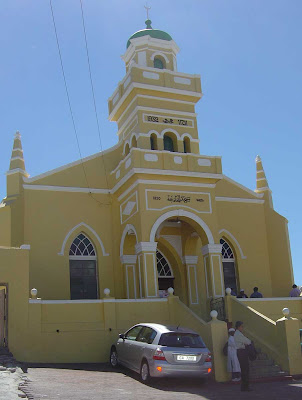| In the 17th century, when the Company occupied almost the entire archipelago, exile the people who become political prisoners and slaves to far into the dark continent, Africa. |
The exiles were placed in the Bo-Kaap, an area in Cape Town, South Africa. From generation to generation, they proliferate and eventually form a Malay village. By accident anyway, eventually dumping into the cause of the spread of Islam in the Cape of Good Hope.
According to the data, the Muslim population in South Africa has now reached 1.5% of the total 44 million population there.
The houses in the Bo-Kaap patterned distinctive blend of East and neoclassical styles.The streets are still made in the original stone from the 17th century, plus a house paint colors that add to the uniqueness of this city. Unique settlement was known as Kampung Melayu or The Malay Quarter.
Population mostly descendants of immigrants from Indonesia, who arrived on the continent of Africa 300 years ago.
The houses in the Bo-Kaap patterned distinctive blend of East and neoclassical styles.The streets are still made in the original stone from the 17th century, plus a house paint colors that add to the uniqueness of this city. Unique settlement was known as Kampung Melayu or The Malay Quarter.
Population mostly descendants of immigrants from Indonesia, who arrived on the continent of Africa 300 years ago.
At first glance, people will believe they are descendants of Malay. Name calling is the names of the typical Malay-Islamic, but the Western family name, two centuries ago due to regulations that require them to have a name that is easier said Dutch. After all, they do not speak Malay, but English and Afrikaans, Dutch type. Only a few Malay words are still tucked in their language.
According to historians, the first Indonesian to arrive in South Africa consisted of slaves or forced laborers who were transported there by the Dutch. According to records at the Bo-Kaap museum, during the period 1652 to 1808 recorded 4890 slaves who arrived in Cape Town, of which 1033 are from Indonesia.
According to historians, the first Indonesian to arrive in South Africa consisted of slaves or forced laborers who were transported there by the Dutch. According to records at the Bo-Kaap museum, during the period 1652 to 1808 recorded 4890 slaves who arrived in Cape Town, of which 1033 are from Indonesia.
There are eleven mosques in the Bo-Kaap. Auwal Mosque is the oldest built in 1798. The mosque is at once a symbol of recognition of the existence of Islam and Muslims in South Africa. Of this mosque also began to spread the teachings of Syafiiyah schools. As with the majority Muslim Indonesia, in South Africa were the majority of Muslims practice Islam according to Imam Syafii schools.
Another thing that stands out is that in this place, although not a Muslim country, but freedom of religion is so high. The majority of Muslim men wear a shirt and a beard. While the women, wearing abayas and some are wearing the hijab or burqa as the cover face.Their work freely with clothes and such an attribute.
Another thing that stands out is that in this place, although not a Muslim country, but freedom of religion is so high. The majority of Muslim men wear a shirt and a beard. While the women, wearing abayas and some are wearing the hijab or burqa as the cover face.Their work freely with clothes and such an attribute.
Have a plan to South Africa? Nothing wrong with Bo-Kaap visit to trace the history of our nation. Who knows families can find a broken chain? Who knows ...




No comments:
Post a Comment